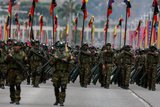Lakota helicopter flies strong in National Capitol Region
The Army extended the presence of the UH-72A Lakota Helicopter into the Military District of Washington, Aug. 11, as it replaced the UH-1 Iroquois Helicopter, or Huey, at Fort Belvoir's Davison Army Airfield.
The Lakota light utility helicopter, a commercial aircraft produced in Columbus, Miss., is used by the Army to conduct homeland security and give administrative and logistic support to training centers. It began replacing the UH-60 Blackhawks in medical evacuation missions when they were sent to Fort Irwin, Calif., in 2007.
The helicopter has since been fielded at Fort Eustis, Va., Fort Polk, La., the US Naval Test Pilot School in Maryland and the US Military Academy in New York. It's also being used outside of the continental United States in Puerto Rico, the Marshall Islands and by the Joint Multinational Readiness Center in Germany.
"We're in the process of setting standards in how quickly we can get critical programs to our Soldiers in the field," said Col. Neil Thurgood, the project manager for the Lakota helicopter.
One hundred thirteen helicopters have been fielded across the military to both active-duty and National Guard units, with most going to the Guard.
"That's very important because it's part of our nation's promise to the Guard to field them with current, modern technology and to support them in their homeland defense missions," Thurgood said.
The Lakota continues to replace Blackhawks in non-combat operations, which can then be sent to Iraq and Afghanistan for missions. It also saves the Army money by easing maintenance issues that older Hueys experience. The Lakota not only does a good job of supporting the mission, but also helps eliminate the Army's fleet of ageing aircraft, Thurgood said. "Both are important for the Army."
The Lakota can be used during search and rescue operations in the aftermath of floods, earthquakes and other natural disasters. It can also be used by the Army National Guard to perform counter-narcotics operations at the border. The primary mission depends on the aircraft's variant, however.
The helicopter can be crafted in five specific variations. There is a VIP variant to fly senior leaders around; a MEDEVAC variant to conduct medical missions; a training-specific modification; a Guard-specific aircraft for homeland security; and a standard-package aircraft used for a variety of missions.
After 40,000 hours of flight time, with 420 trained pilots, the feedback from operators is positive, Thurgood said. Pilots like the modern digital cockpit, the stability, the navigation system and the seating position, and some of the models are equipped with air conditioning.
All Lakota pilots are provided with Federal Aviation Administration training in Granbury, Texas, and the impact the helicopter has on the country's economy is an additional advantage.
"The aircraft production has shifted from Germany to America," Thurgood said. "That's very important economically to our nation, it's very important to our jobs and it's very important to our states."
The Army has taken steps to ensure a smooth fielding process, an extensive mission set and encouraging feedback. These measures have led to a successful implementation of the Lakota helicopter with support from senior leaders.
The process has been successful because the Army is tied directly to users, forming a relationship with every unit using the helicopter. Leadership has worked hard to acquire funding leading to an accelerated program. And this is an instance where the Army has taken advantage of the marketplace instead of tasking industry with building a specific aircraft, Thurgood said.
These factors have led to rapid acquisition, and the fielding process isn't slowing down. The Army is set to field the Lakota at Aberdeen Proving Ground and for National Guard units in Yakima, Wash., and Virginia for the remainder of the year. Sixty-two Lakota helicopters will be sent to 12 different sites next year.
By Matthew Hickman (OCPA, ARNews) - United States Army
More from Defence Helicopter
-
![Germany to send WS-61 Westland Sea King helicopters to Ukraine]()
Germany to send WS-61 Westland Sea King helicopters to Ukraine
Germany has committed to sending Ukraine six of its 21 retiring WS-61 Westland Sea King multirole, amphibious helicopters.
-
![Boeing secures $271 million to advance modernisation of US Special Operations' MH-47G Chinook]()
Boeing secures $271 million to advance modernisation of US Special Operations' MH-47G Chinook
Boeing has clinched a major contract modification to further its backing of the US Special Operations Command’s MH-47G Chinook aircraft modernisation effort.
-
![Dubai Airshow 2023: South Korean homegrown helicopters make international debut]()
Dubai Airshow 2023: South Korean homegrown helicopters make international debut
Two KAI helicopters, the KUH-1E utility helicopter and the Light Attack Helicopter (LAH), have taken centre stage at the Dubai Airshow 2023.
-
![Italian Navy receives final NH90 helicopter]()
Italian Navy receives final NH90 helicopter
The Italian Navy now boasts a fleet of 56 NH90 helicopters comprising 46 SH-90As and 10 MH-90As.
-
![Argentina seeks AW109 and CH-46 Sea Knight helicopters]()
Argentina seeks AW109 and CH-46 Sea Knight helicopters
The Argentinian Air Force (FAA) and the Argentinian Naval Aviation Command (COAN) are looking for options to upgrade their helicopter fleets.
-
![DSEI 2023: Lockheed to produce about 40% of Black Hawks on UK soil if it wins NMH contest]()
DSEI 2023: Lockheed to produce about 40% of Black Hawks on UK soil if it wins NMH contest
Lockheed Martin promises a boost to the British job market and export opportunities, while strengthening ties with Poland and positioning the UK for a future in rotorcraft technology in the event of a New Medium Helicopter competition triumph.
























